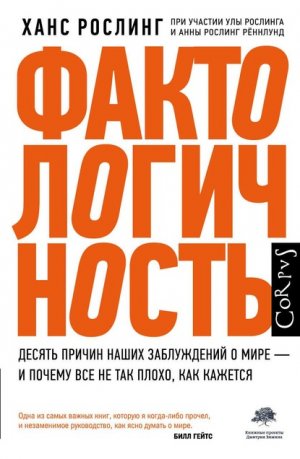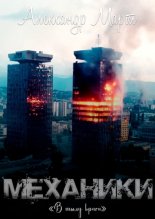Фактологичность. Десять причин наших заблуждений о мире – и почему все не так плохо, как кажется Рослинг Ханс

UN-Pop[9]. World Contraceptive Use 2017. World Population Prospects 2017. UN Population Division, March 2017. Accessed December 2, 2017. gapm.io/xcontr.
UNAIDS. «AIDSinfo». Accessed October 4, 2017. http://aidsinfo.unaids.org.
UNDESA (United Nations Department of Economic and Social Affairs). «Electricity and education: The benefits, barriers, and recommendations for achieving the electrification of primary and secondary schools». December 2014. gapm.io/xdessel.
UNEP[1] (United Nations Environment Programme). Towards a Pollution-Free Planet. Nairobi: United Nations Environment Programme, 2017. gapm.io/xpolfr17.
UNEP[2]. Regional Lead Matrix documents published between 1990 and 2012. gapm.io/xuneplmats.
UNEP[3]. «Leaded Petrol Phase-out: Global Status as at March 2017». Accessed November 29, 2017. gapm.io/xunepppo.
UNEP[4]. Ozone data access center: ODS consumption in ODP tonnes. Data updated November 13, 2017. Accessed November 24, 217. gapm.io/xods17.
UNEP[5]. The World Database on Protected Areas (WDPA). UNEP, IUCN, and UNEP-WCMC. https://protectedplanet.net.
UNEP[6]. Protected Planet Report 2016. UNEP-WCMC and IUCN, Cambridge, UK, and Gland, Switzerland, 2016. Accessed December 17, 2017. gapm.io/xprotp16.
UNESCO[1] (United Nations Educational, Scientific and Cultural Organization). «Education: Completion rate for primary education (household survey data)». Accessed November 5, 2017. gapm.io/xcomplr.
UNESCO[2]. «Education: Literacy rate». Last modified July 2017. Accessed November 5, 2017. gapm.io/xuislit.
UNESCO[3]. «Education: Out-of-school rate for children of primary school age, female». Accessed November 26, 2017. gapm.io/xuisoutsf.
UNESCO[4]. «Rate of out-of-school children». Accessed November 29, 2017. gapm.io/xoos.
UNESCO[5]. «Reducing global poverty through universal primary and secondary education». June 2017. gapm.io/xprimsecpov.
UNFPA[1] (United Nations Population Fund). «Sexual & reproductive health». Last updated November 16, 2017. http://www.unfpa.org/sexual-reproductive-health.
UNHCR (United Nations High Commissioner for Refugees). «Convention and protocol relating to the status of refugees». UN Refugee Agency, Geneva. gapm.io/xunhcr.
UNICEF-MICS. Multiple Indicator Cluster Surveys. Funded by the United Nations Children’s Fund. Accessed November 29, 2017. http:// mics.unicef.org.
UNICEF[1]. The State of the World’s Children 1995. Oxford, UK: Oxford University Press, 1995. gapm.io/xstchi.
UNICEF[2]. «Narrowing the Gaps — The Power of Investing in the Poorest Children». July 2017. gapm.io/xunicef2.
UNICEF[3]. «Diarrhoea remains a leading killer of young children, despite the availability of a simple treatment solution». Accessed September 11, 2017. gapm.io/xunicef3.
UNICEF[4]. «The State of the World’s Children 2013 — Children with Disabilities». 2013. gapm.io/x-unicef4.
UNICEF[5]. «Vaccine Procurement Services». https://www.unicef.org/supply/index_54052.html.
UNISDR (United Nations Office for Disaster Risk Reduction). «Heat wave in Europe in 2003: new data shows Italy as the most affected country». UNISDR, 2003. gapm.io/x-unicefC5.
US Census Bureau. Current Population Survey, 2017 Annual Social and Economic Supplement. Table: «FINC01_01. Selected Characteristics of Families by Total Money Income in: 2016,» monetary income, all races, all families. gapm.io/xuscb17.
US-CPS. Current Population Survey 2016: Family Income in 2016.
USAID-DHS[1]. Demographic and Health Surveys (DHS), funded by USAID. https://dhsprogram.com.
USAID-DHS[2]. Bietsch K., Westoff C. F. Religion and Reproductive Behavior in Sub-Saharan Africa. DHS Analytical Studies. No. 48. Rockville, MD: ICF International, 2015. gapm.io/xdhsarel.
van Zanden[1]. Van Zanden J. L., Baten J., Foldvari P., van Leeuwen B. «World Income Inequality: The Changing Shape of Global Inequality 1820–2000». Utrecht University, 2014. http://www.basvanleeuwen.net/bestanden/WorldIncomeInequality.pdf.
van Zanden[2]. Van Zanden J. L., Buringh E. «Rise of the West: Manuscripts and Printed Books in Europe: A long-term perspective from the sixth through eighteenth centuries» // Journal of Economic History. 2009. Vol. 69 (February). No. 2. P. 409–445. gapm.io/xriwe.
van Zanden[3]. How Was Life? Global Well-Being Since 1820 / Ed. by J. L. van Zanden et al. Paris: OECD Publishing, 2014. gapm.io/x-zanoecd.
WEF (World Economic Forum). «Davos 2015 — Sustainable Development: Demystifying the Facts». Filmed Davos, Switzerland, January 2015. WEF video, 15:42. Видео по ссылке начинается с 5-й минуты 18-й секунды на моменте презентации, в которой Ханс показывает аудитории результаты тестирования: https://youtu.be/3pVlaEbpJ7k?t=5m18s.
White[1]. White M. The Great Big Book of Horrible Things. New York: W. W. Norton, 2011.
White[2]. White M. Estimates of death tolls in World War II. Necrometrics. http://necrometrics.com/20c5m.htm#Second.
WHO[1]. «Global Health Observatory data repository: Immunization». Accessed November 2, 2017. gapm.io/xwhoim.
WHO[2]. Safe abortion: Technical & policy guidance for health systems. gapm.io/xabor.
WHO[3]. WHO Ebola Response Team. «Ebola Virus Disease in West Africa — The First 9 Months of the Epidemic and Forward Projections» // New England Journal of Medicine. 2014. Vol. 371 (October 6). P. 1481–1495. gapm.io/xeboresp.
WHO[4]. «Causes of child mortality». Global Health Observatory (GHO) data. Accessed September 12, 2017. gapm.io/xeboresp2.
WHO[5]. «1986–2016: Chernobyl at 30». April 25, 2016. gapm.io/xwhoc30.
WHO[6]. «The use of DDT in malaria vector control: WHO position statement». Global Malaria Programme, World Health Organization, 2011. gapm.io/xwhoddt1.
WHO[7]. «DDT in Indoor Residual Spraying: Human Health Aspects — Environmental Health Criteria 241». World Health Organization, 2011. gapm.io/xwhoddt2.
WHO[8]. «WHO Global Health Workforce Statistics». World Health Organization, 2016. gapm.io/xwhowf.
WHO[9]. Situation updates — Pandemic. gapm.io/xwhopand.
WHO[10]. Data Tuberculosis (TB) Global Health Observatory (GHO) data, http://www.who.int/gho/tb/.
WHO[11]. «What is multidrug-resistant tuberculosis (MDR-TB) and how do we control it?» gapm.io/xmdrtb.
WHO[12]. «Global Health Expenditure Database». Last updated December 5, 2017. http://apps.who.int/nha/database.
WHO[13]. Ebola situation reports. gapm.io/xebolawho.
WHO[14]. Antimicrobial resistance. gapm.io/xantimicres.
WHO[15]. Neglected tropical diseases. gapm.io/xnegtrop.
WHO[16]. «Evaluation of the international drinking water supply and sanitation decade, 1981–1990». World Health Organization, November 21, 1991. Executive board, eighty-ninth session. Page 4. gapm.io/xwhow90.
WHO[17]. Emergencies preparedness, response. Situation updates — Pandemic (H1N1) 2009. http://www.who.int/csr/disease/swineflu/updates/en/index.html.
WHO[18]. Data Tuberculosis (TB) Global Health Observatory (GHO) data, http://www.who.int/gho/tb/en/.
WHO/UNICEF. «Ending Preventable Child Deaths from Pneumonia and Diarrhoea by 2025». World Health Organization/The United Nations Children’s Fund (UNICEF), 2013. gapm.io/xpneuDiarr.
WHO/UNICEF JMP (Joint Monitoring Programme). «Drinking water, sanitation and hygiene levels». 2015. https://washdata.org/data.
Wikipedia[1]. «Timeline of abolition of slavery and serfdom». https://en.wikipedia.org/wiki/Timeline_of_abolition_of_slavery_and_serfdom.
Wikipedia[2]. «Capital punishment by country: Abolition chronology». https://en.wikipedia.org/wiki/Capital_punishment_by_country#Abolition_chronology.
Wikipedia[3]. «Feature film: History». https://en.wikipedia.org/wiki/Feature_film#History.
Wikipedia[4]. «Women’s suffrage». https://en.wikipedia.org/wiki/Women%27s_suffrage.
Wikipedia[5]. «Sound recording and reproduction: Phonoautograph». https://en.wikipedia.org/wiki/Sound_recording_and_reproduction#Phonautograph.
Wikipedia[6]. «World War II casualties». https://en.wikipedia.org/wiki/World_War_II_casualties.
Wikipedia[7]. «List of terrorist incidents: 1970–present». https://en.wikipedia.org/wiki/List_of_terrorist_incidents#1970–present.
Wikipedia[8]. «Cobratoxin: Multiple sclerosis». https://en.wikipedia.org/wiki/Cobratoxin#cite_note-pmid21999367–8.
Wikipedia[9]. «Charles Waterton». https://en.wikipedia.org/wiki/Charles_Waterton.
Wikipedia[10]. «Recovery position». https://en.wikipedia.org/wiki/Recovery_position.
World Bank[1]. «Indicator GDP per capita, PPP (constant 2011 international $)». International Comparison Program database. Downloaded October 22, 2017. gapm.io/xwb171.
World Bank[2]. «World Bank Country and Lending Groups». Accessed November 6, 2017. gapm.io/xwb172.
World Bank[3]. «Primary completion rate, female (% of relevant age group)». Accessed November 5, 2017. gapm.io/xwb173.
World Bank[4]. «Population of Country Income Groups in 2015 — Population, total». Accessed November 7, 2017. gapm.io/xwb174.
World Bank[5]. «Poverty headcount ratio at $1.90 a day (2011 PPP) (% of population)». Development Research Group. Downloaded October 30, 2017. gapm.io/xwb175.
World Bank[6]. «Indicator Access to electricity (% of population)». Sustainable Energy for All (SEforALL) Global Tracking Framework. International Energy Agency and the Energy Sector Management Assistance Program, 2017. gapm.io/xwb176.
World Bank[7]. «Life expectancy at birth, total (years)». United Nations Statistical Division. Population and Vital Statistics Reports (various years). Accessed November 8, 2017. gapm.io/xwb177.
World Bank[8]. «Improved water source (% of population with access)». WHO/UNICEF Joint Monitoring Programme (JMP) for Water Supply and Sanitation. Accessed November 8, 2017. gapm.io/xwb178.
World Bank[9]. «Immunization, measles (% of population with access)». Accessed November 8, 2017. gapm.io/xwb179.
World Bank[10]. «Prevalence of undernourishment (% of population)». Food and Agriculture Organization. Accessed November 8, 2017. gapm. io/xwb1710.
World Bank[11]. «Out-of-pocket health expenditure (% of total expenditure on health)». Global Health Expenditure database, 2017. gapm.io/xwb1711.
World Bank[12]. Narayan D., Patel R. et al. Voices of the Poor: Can Anyone Hear Us? New York: Oxford University Press, 2000. gapm.io/xwb1712.
World Bank[13]. «International tourism: number of departures». Yearbook of Tourism Statistics, Compendium of Tourism Statistics and data files, World Tourism Organization, 2017. gapm.io/xwb1713.
World Bank[14]. «Beyond Open Data: A New Challenge from Hans Rosling.» Live GMT, June 8, 2015. gapm.io/xwb1714.
World Bank[15]. Khokhar T. «Should we continue to use the term ‘developing world’?» // The Data blog. World Bank. November 16, 2015. gapm.io/xwb1715.
World Bank[16]. «Income share held by highest 10 %». Development Research Group, 2017. gapm.io/xwb1716.
World Bank[17]. Jolliffe D., Prydz E. B. «Estimating International Poverty Lines from Comparable National Thresholds». World Bank Group, 2016. gapm.io/xwb1717.
World Bank[18]. «Mobile cellular subscriptions». International Telecommunication Union, World Telecommunication/ICT Development Report and database. Downloaded November 26, 2017. gapm.io/xwb1718.
World Bank[19]. «Individuals using the Internet (% of population)». International Telecommunication Union, World Telecommunication/ICT Development Report and database. Downloaded November 27, 2017. gapm.io/xwb1719.
World Bank[20] Global Consumption Database. http://datatopics.world bank.org/consumption.
World Bank[21]. «School enrollment, primary and secondary (gross), gender parity index (GPI)». United Nations Educational, Scientific, and Cultural Organization (UNESCO) Institute for Statistics, 2017. gapm. io/xwb1721.
World Bank[22]. «Global Consumption Database». World Bank Group, 2017. gapm.io/xwb1722.
World Bank[23]. «Physicians (per 1,000 people)». Selected countries and economies; Sweden and Mozambique. World Health Organization, Global Health Workforce Statistics, OECD, 2017. gapm.io/xwb1723.
World Bank[24]. «Health expenditure per capita, PPP (constant 2011 international $)». World Health Organization Global Health Expenditure Database, 2017. gapm.io/xwb1724.
World Bank[25]. Newhouse D., Suarez-Becerra P., Evans M. C. «New Estimates of Extreme Poverty for Children — Poverty and Shared Prosperity Report 2016: Taking On Equality». Policy Research Working Paper no. 7845. World Bank, Washington, DC, 2016.
World Bank[26] Group, Poverty and Equality Global Practice Group, October 2016. gapm.io/xwb1726.
World Bank[27]. World Bank Open Data platform. https://data.worldbank.org.
WorldPop. Case Studies — Poverty. gapm.io/xworpopcs.
WWF. Tiger — Facts. 2017. Accessed November 5, 2017. gapm.io/xwwf tiger.
YouGov[1]. November — December 2015. Poll results: gapm.io/xyougov15. YouGov[2]. Poll about fears. 2014. gapm.io/xyougov15.
Zakaria F. The Future of Freedom: Illiberal Democracy at Home and Abroad. New York: W. W. Norton, 2003.
Zakaria F. The Post-American World. New York: W. W. Norton, 2008.
Биографии авторов
Ханс родился в Уппсале (Швеция) в 1948 году. Он изучал статистику и медицину в Уппсальском университете и общественное здравоохранение в Медицинском колледже Сент-Джонс в Бангалоре (Индия). В 1976 году он получил диплом врача. В период с 1974 по 1984 год он провел 18 месяцев дома в отпуске по уходу за тремя своими детьми. С 1979 по 1981 годы Ханс работал окружным врачом в Накале (Мозамбик), где открыл прежде не описанную паралитическую болезнь, которая теперь называется конзо. Проведя исследование этой болезни, в 1986 году он получил докторскую степень в Уппсальском университете. С 1997 года Ханс был профессором международного здравоохранения в Каролинском институте — медицинском университете Стокгольма (Швеция). В своих исследованиях он изучал здравоохранения в Каролинском институте — медицинском университете Стокгольма (Швеция). В своих исследованиях он изучал здравоохранения в Каролинском институте — медицинском университете Стокгольма (Швеция). В своих исследованиях он изучал взаимосвязи экономического развития, сельского хозяйства, бедности и здоровья. Он также разрабатывал новые учебные курсы, вел партнерские исследования и стал одним из авторов учебника по глобальному здравоохранению.
В 2005 году Ханс вместе со своим сыном Улой Рослингом и снохой Анной Рослинг Рённлунд основал Gapminder Foundation для борьбы с повальным невежеством посредством пропаганды фактологической картины мира, понятной каждому. Ханс читал лекции в финансовых, коммерческих и неправительственных организациях, а десять его выступлений на TED просмотрели в общей сложности более 35 миллионов раз.
Ханс был консультантом Всемирной организации здравоохранения, ЮНИСЕФ и нескольких гуманитарных организаций, а также стал одним из основателей шведского отделения «Врачей без границ». Он участвовал в создании трех документальных фильмов BBC, в которых выступил рассказчиком: The Joy of Stats (2010), Don’t Panic — The Truth About Population (2013) и Don’t Panic: How to End Poverty in 15 Years (2015). Ханс был членом международного отдела Шведской академии наук и Совета по глобальной повестке Всемирного экономического форума в Швейцарии. В 2009 году он вошел в список 100 ведущих мировых мыслителей, составленный журналом Foreign Policy, в 2011 году — в список 100 самых креативных людей бизнеса составленный журналом Fast Company, а в 2012 году — в список 100 наиболее влиятельных людей в мире, составленный журналом Time.
Ханс с женой, Агнетой Рослинг, воспитали троих детей: Анну, Улу и Магнуса. Ханс скончался 7 февраля 2017 года.
Ула Рослинг родился в Худиксвалле (Швеция) в 1975 году. Он стал одним из основателей Gapminder Foundation и был директором фонда с 2005 по 2007 год, а также продолжает им быть с 2010 года по настоящее время.
Именно Ула придумал и разработал тесты Gapminder на выявление невежества, структурированную оценку невежества и процесс сертификации. Он собирал данные и готовил материалы для большинства лекций Ханса и его выступлений на TED. С 1999 года Ула возглавил группу по разработке знаменитого инструмента для создания анимированных пузырьковых диаграмм, который получил название Trendalyzer и сегодня используется миллионами студентов по всему миру для анализа многомерных динамических рядов. В 2007 году инструмент купила компания Google, в которой Ула с 2007 по 2010 год возглавлял отдел по работе с открытыми данными. Затем он вернулся в Gapminder, чтобы продолжить разработку бесплатных учебных материалов. Ула читает множество лекций, а его совместное выступление с Хансом на TED набрало несколько миллионов просмотров.
За свою работу в Gapminder Ула удостоился ряда наград, включая награду Rsum за активное распространение информации и премию Guldgget Titanpriset в 2017 году, а также награду Niras за комплексное международное развитие в 2016 году.
Ула женат на Анне Рослинг Рённлунд. У них трое детей: Макс, Тед и Эбба.
Анна родилась в Фалуне (Швеция) в 1975 году. Она изучала социологию в Лундском университете и фотографию в Гетеборгском университете и впоследствии стала одним из основателей и вице-президентом Gapminder Foundation.
В Gapminder Анна взяла на себя заботу о конечных пользователях: именно она объясняет, как работать с материалами фонда, и проверяет, чтобы ни у кого не возникало с ними затруднений. Вместе с Улой Анна писала сценарии для выступлений Ханса на TED и других его лекций, готовила графику и слайды, а также разрабатывала пользовательский интерфейс инструмента для создания анимированных пузырьковых диаграмм Trendalyzer. Когда в 2007 году инструмент приобрела компания Google, Анна заняла в Google должность старшего специалиста по юзабилити. В 2010 году Анна вернулась в Gapminder, чтобы продолжить разработку бесплатных учебных материалов.
Запущенный в 2016 году проект «Долларовая улица» стал детищем Анны. В 2017 году она рассказала о нем в своем выступлении на TED.
За свою работу в Gapminder Анна удостоилась ряда наград, включая награду Rsum за активное распространение информации и премию Guldgget Titanpriset, а также полученную в 2017 году награду Fast Company за прорывную идею.
Анна замужем за Улой Рослингом. У них трое детей: Макс, Тед и Эбба.






